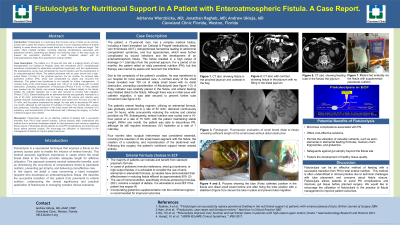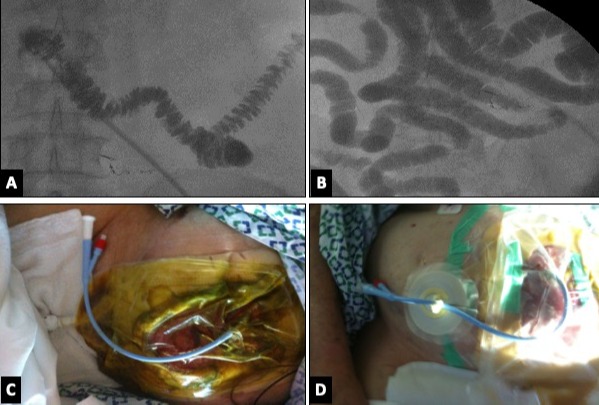Sunday Poster Session
Category: Small Intestine
P1285 - Fistuloclysis for Nutritional Support in a Patient with Enteroatmospheric Fistula: A Case Report
Sunday, October 22, 2023
3:30 PM - 7:00 PM PT
Location: Exhibit Hall

Has Audio

Adrianna Wierzbicka, MD
Cleveland Clinic Florida
Weston, FL
Presenting Author(s)
Adrianna Wierzbicka, MD, Jonathan Ragheb, MD, Andrew Ukleja,
Cleveland Clinic Florida, Weston, FL
Introduction:
Fistuloclysis is a technique of using a fistula as the primary access site to allow infusion of enteral formula. It is an important method of enteral feeding in fistulas when the small bowel distal to the fistula is of sufficient length. This option presents multiple benefits including the reduction of parenteral nutrition complications, gut atrophy, and costs. We present a case of a heart transplant patient with enteroatmospheric fistula, who was successfully switched from parenteral to enteral nutrition.
Case Description/Methods: The patient is a 72-year old man with a past history of heart transplantation (on Cellcept & Prograf), DVT, retroperitoneal hematoma complicated by abdominal compartment syndrome, s/p laparotomies (x4) with postoperative course complicated by wound infection and enteroatmospheric fistula. The patient had an open wound with a high output fistula ( >1L/day) in the proximal jejunum. He was on daily parenteral nutrition (PN) for 6 months. His PN therapy was complicated by sepsis and recurrent line infections. The patient was transferred to our hospital for further management. After a small bowel assessment by contrast study revealed over 100 cm of small bowel and no distal obstruction, fistuloclysis was considered (Photos A&B). A foley catheter was placed in the fistula and enteral feeding was initiated distally to fistula. The catheter initially migrated but was later secured to prevent tube migration (Photos C&D). The enteral feeding with elemental formula was advanced gradually to a rate of 50 ml/hr given over 24 hours while PN volume and calories were reduced partially. Later, enteral nutrition was cycled over 16 hr. at rate 75 ml/hr, and the patient maintained the weight. He was able to discontinue PN within 1 month, although he still required IV hydration (1L/day). Four months later, surgery was performed including resecting the small bowel with fistula, forming the colostomy, and reconstructing the abdominal wall. Following the surgery, no nutrition support was needed.
Discussion: Fistuloclysis can be an effective method of feeding with a successful transition from PN to total enteral nutrition. This method is often underutilized in clinical practice due to technical challenges with tube placement and concern about fistula closure. Fistuloclysis allows patients to avoid PN complications and improves gut tissue before planned surgery. We would like to encourage the utilization of fistuloclysis in the practice of fistula management to improve patient outcomes.

Disclosures:
Adrianna Wierzbicka, MD, Jonathan Ragheb, MD, Andrew Ukleja, . P1285 - Fistuloclysis for Nutritional Support in a Patient with Enteroatmospheric Fistula: A Case Report, ACG 2023 Annual Scientific Meeting Abstracts. Vancouver, BC, Canada: American College of Gastroenterology.
Cleveland Clinic Florida, Weston, FL
Introduction:
Fistuloclysis is a technique of using a fistula as the primary access site to allow infusion of enteral formula. It is an important method of enteral feeding in fistulas when the small bowel distal to the fistula is of sufficient length. This option presents multiple benefits including the reduction of parenteral nutrition complications, gut atrophy, and costs. We present a case of a heart transplant patient with enteroatmospheric fistula, who was successfully switched from parenteral to enteral nutrition.
Case Description/Methods: The patient is a 72-year old man with a past history of heart transplantation (on Cellcept & Prograf), DVT, retroperitoneal hematoma complicated by abdominal compartment syndrome, s/p laparotomies (x4) with postoperative course complicated by wound infection and enteroatmospheric fistula. The patient had an open wound with a high output fistula ( >1L/day) in the proximal jejunum. He was on daily parenteral nutrition (PN) for 6 months. His PN therapy was complicated by sepsis and recurrent line infections. The patient was transferred to our hospital for further management. After a small bowel assessment by contrast study revealed over 100 cm of small bowel and no distal obstruction, fistuloclysis was considered (Photos A&B). A foley catheter was placed in the fistula and enteral feeding was initiated distally to fistula. The catheter initially migrated but was later secured to prevent tube migration (Photos C&D). The enteral feeding with elemental formula was advanced gradually to a rate of 50 ml/hr given over 24 hours while PN volume and calories were reduced partially. Later, enteral nutrition was cycled over 16 hr. at rate 75 ml/hr, and the patient maintained the weight. He was able to discontinue PN within 1 month, although he still required IV hydration (1L/day). Four months later, surgery was performed including resecting the small bowel with fistula, forming the colostomy, and reconstructing the abdominal wall. Following the surgery, no nutrition support was needed.
Discussion: Fistuloclysis can be an effective method of feeding with a successful transition from PN to total enteral nutrition. This method is often underutilized in clinical practice due to technical challenges with tube placement and concern about fistula closure. Fistuloclysis allows patients to avoid PN complications and improves gut tissue before planned surgery. We would like to encourage the utilization of fistuloclysis in the practice of fistula management to improve patient outcomes.

Figure: A & B. Small bowel fluoroscopic evaluation of small bowel distal to fistula revealing sufficient length of the small bowel and no distal obstruction.
C&D. Pictures showing the tube position in the fistula including fixed tube position with a stabilizer to secure the tube position and prevent the tube migration.
C&D. Pictures showing the tube position in the fistula including fixed tube position with a stabilizer to secure the tube position and prevent the tube migration.
Disclosures:
Adrianna Wierzbicka indicated no relevant financial relationships.
Jonathan Ragheb indicated no relevant financial relationships.
Andrew Ukleja indicated no relevant financial relationships.
Adrianna Wierzbicka, MD, Jonathan Ragheb, MD, Andrew Ukleja, . P1285 - Fistuloclysis for Nutritional Support in a Patient with Enteroatmospheric Fistula: A Case Report, ACG 2023 Annual Scientific Meeting Abstracts. Vancouver, BC, Canada: American College of Gastroenterology.
